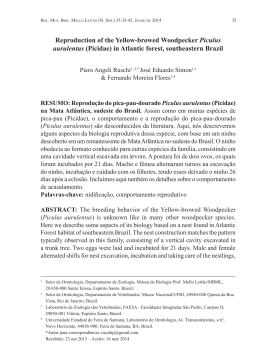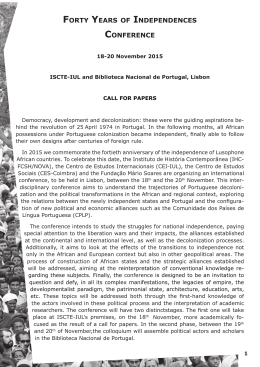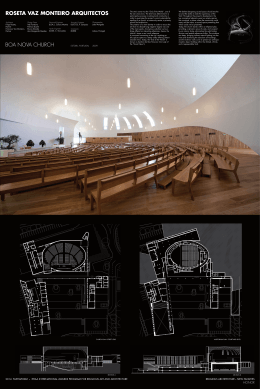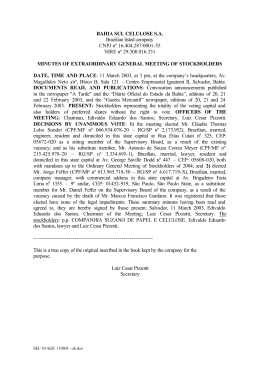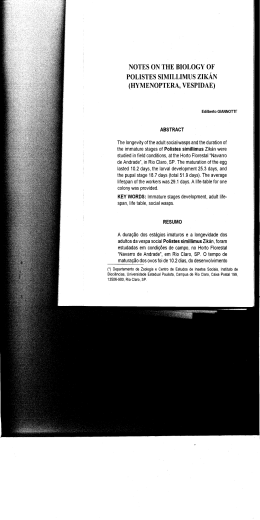Cotinga30-080617:Cotinga Cotinga 30 8. 9. 10. 11. 12. 13. 6/17/2008 8:11 AM Page 65 Altitudinal and geographical range extension for Bicoloured Antvireo talis), with notes on its behavior in eastern Ecuador. Orn. Neotrop. 13: 1–3. Greeney, H. F. (2004) Breeding behavior of the Bicolored Antvireo (Dysithamnus occidentalis). Orn. Neotrop. 15: 349–356. Krabbe, N. & Palacio, J. (1999) Range extensions of Bicoloured Antvireo Dysithamnus occidentalis in Ecuador. Cotinga 11: 48. Krabbe, N., Agro, D. J., Rice, N. H., Jácome, N., Navarrete, L. & Sornoza M., F. (1999) A new species of antpitta (Formicariidae: Grallaria) from the southern Ecuadorian Andes. Auk 116: 882–890. Ridgely, R. S. & Greenfield, P. J. (2001) The birds of Ecuador, 1. Ithaca, NY: Cornell University Press. Ridgely, R. S. & Tudor, G. (1994) The birds of South America, 2. Austin: University of Texas Press. Schulenberg, T. S., Stotz, D. F., Lane, D. F., O’Neill, J. P. & Parker, T. A. (2007) Birds of Peru. Princeton, NJ: Princeton University Press. 14. Whitney, B. M. (1992) Observations on the systematics, behavior, and vocalizations of “Thamnomanes” occidentalis (Formicariidae). Auk 109: 302–308. 15. Zimmer, K. J. & Isler, M. L. (2003) Family Thamnophilidae (typical antbirds). In: del Hoyo, J., Elliott, A. & Christie, D. A. (eds.) Handbook of the birds of the world, 8. Barcelona: Lynx Edicions. J. Berton C. Harris, Rolando L. Carpio A. and Mary K. Chambers Fundación de Conservación Jocotoco, Av. Los Shyris N37–146 y El Comercio, Quito, Ecuador. E-mail: [email protected]. Harold F. Greeney Yanayacu Biological Station & Center for Creative Studies, Cosanga, Ecuador, c/o 721 Foch y Amazonas, Quito, Ecuador. Reproductive notes on the Slender Antbird Rhopornis ardesiacus Edson Ribeiro Luiz Received 4 May 2007; final revision accepted 13 February 2008 Cotinga 30 (2008): 65–67 Esse trabalho apresenta dados inéditos relacionados a aspectos reprodutivos do gravatazeiro Rhopornis ardesiacus, incluindo a descrição do ninho e a documentação fotográfica de ovos e filhotes encontrados em novembro de 2005 na Fazenda Alvorada, município de Boa Nova, Bahia. Apesar do ninho da espécie ter sido descrito pela primeira vez em 1987, as informações aqui apresentadas não corroboram a descrição existente na literatura que foi baseada apenas em evidências indiretas e interpretadas erroneamente. As informações apresentadas são de grande importância no delineamento das ações de conservação propostas para a conservação da espécie na região. The Brazilian endemic Slender Antbird Rhopornis ardesiacus is considered Endangered at global and national levels1,6. Despite being well known amongst birdwatchers, there are few published data concerning its basic biology. Described in 1817, by Wied, from the state of Bahia5, it was only rediscovered in 1928, by Emil Kaemper around Boa Nova and Ituaçu7. In the 1970s and 1980s other records were made in the same region of south-east Bahia11,13,14. For many years the species was considered to be restricted to mata de cipó (at 700–1,000 m)10 and it was not until until 1999 that R. ardesiacus was found in a forest remnant at Fazenda Santana, near Salto da Divisa, Minas Gerais, where the vegetation is classified as lowland semi-deciduous forest, at c.100 m9. However, in both areas the presence of R. ardesiacus is closely associated with large terrestrial bromeliads known to be used by the species5,7,9–11,13,14. The few data concerning the Slender Antbird’s natural history concern its foraging behaviour, home range and vocalisations (at Boa Nova), and morphology and habitat use (Fazenda Santana)9,14. Until now, the only information concerning breeding biology involves a nest supposedly of this species found at Boa Nova13, which was described as having recently been built and contained feathers of a female R. ardesiacus. It was mainly constructed of dry leaves and had an elliptical shape, with a tunnel and side entrance. The nest was positioned 25 cm above ground, supported by two terrestrial bromeliads known as gravatás. However, Teixeira never saw a Slender Antbird attend the nest, but concluded that it belonged to R. ardesiacus based on indirect evidence, pointing out that the structure was similar to nests of Pyriglena species13. Here I describe for the first time a R. ardesiacus nest based on direct observations. In addition to the nest description, details of the eggs and nestlings are also presented. 65 Cotinga30-080617:Cotinga 6/17/2008 8:11 AM Page 66 Reproductive notes on the Slender Antbird Cotinga 30 Figure 1. Area of Gravatás in which the nest of Slender Antbird Rhopornis ardesiacus was sited, Boa Nova, Bahia, Brazil, November 2005 (Edson Ribeiro Luiz) Figure 2. Nest and eggs of Slender Antbird Rhopornis ardesiacus, Boa Nova, Bahia, Brazil, November 2005 (Edson Ribeiro Luiz) Figure 3. Incubating female Slender Antbird Rhopornis ardesiacus, Boa Nova, Bahia, Brazil, November 2005 (Edson Ribeiro Luiz) Figure 4. Slender Antbird Rhopornis ardesiacus nestlings, Boa Nova, Bahia, Brazil, November 2005 (Edson Ribeiro Luiz) Study site Results The observations described here were made at Fazenda Alvorada (14°19’S 40°12’W; 770 m), 5 km from Boa Nova, Bahia, in the same area where Willis & Oniki14 conducted their studies of R. ardesiacus. The farm comprises 205 ha, with fragments of secondary mata de cipó subject to selective extraction and the constant presence of cattle in the forest. On 14 November a pair of Rhopornis was observed carrying nest material to an area with many gravatás, but no attempt was made to find the precise nest site because birds disturbed at the construction stage sometimes abandon the nest, and also due to the difficult access (Fig. 1). The male only entered the environs of the nest site after the female had done so, otherwise it would pause c.2 m from the nest (estimated after the nest’s subsequent discovery) and emit a typical vocalisation (8–9 notes). Once the female had arrived, the pair would enter the nest site (the female always leading). On 28 November, the nest was found. It was placed at ground level, but resting on a dry gravatá leaf attached to the base of the plant. The nest was a low cup12 (2.7 cm deep), with an external diameter of 9 cm, mainly comprised of pieces of dry leaves and vines. The clutch consisted of two pale pink eggs (25 × 16 mm) with small red spots (Fig. 2). The nest was sited 8 m from the forest edge. Methods In August–November 2005, I searched for evidence of breeding by Slender Antbird. Six pairs were followed using direct observations, for c.20 minutes, every other day. The clusters of large terrestrial bromeliads were also checked, especially those of the genus Aechmea. Effort was concentrated on a pair in one woodlot, due to easy access and regular observations of this pair, suggesting that the birds posssessed a well-defined territory. 66 Cotinga30-080617:Cotinga 6/17/2008 1:38 PM Page 67 Reproductive notes on the Slender Antbird Cotinga 30 Both sexes (Fig. 3) incubated the eggs, and the incubation period occupied 13 days after the nest was found. On hatching, the nestlings possessed bare bluish skin with some pink parts and an intense yellow bill (Fig. 4). On 18 December, six days after hatching, the young had vanished from the nest, presumably having been predated. and Eloisa Sari helped with English revision. Birders Exchange provided equipment. The Partnership Fund for Critical Ecosystems (CEPF), the Dutch government and Disney Wildlife Conservation Fund financed the research, whilst Boa Nova municipality provided logistic support. Discussion 1. BirdLife International (2004) Threatened birds of the world 2004. CD-ROM. Cambridge, UK: BirdLife International. 2. Davis, D. E. (1945) The occurrence of the incubation-patch in some Brazilian birds. Wilson Bull. 57: 188–190. 3. Leite, L. O. & Marini, M. Â. (1999) The effects of forest fragmentation on predation rates of artificial bird nests in Minas Gerais. J. Braz. Assoc. Advancement Sci. 51: 34–37. 4. Marini, M. A., Robinson, S. K. & Heske, E. J. (1995) Edge effects on nest predation in the Shawnee National Forest, southern Illinois. Biol. Conserv. 74: 203–213. 5. Meyer de Schauensee, R. (1970) A guide to the birds of South America. Philadelphia: Acad. Nat. Sci. Philadelphia. 6. Ministério do Meio Ambiente (2004) Lista nacional das espécies da fauna brasileira ameaçada de extinção. www.mma.gov.br/port/sbf/fauna/ index.cfm (accessed 7 November 2006). 7. Naumburg, E. M. (1934) Rediscovery of Rhopornis ardesiaca (Wied). Auk 51: 493–496. 8. Pinto, O. M. O. (1978) Novo catálogo de aves do Brasil. São Paulo: Conselho Nacional de Desenvolvimento Científico e Tecnológico. 9. Ribon, R. & Maldonado-Coelho, M. (2001) Range extension for Slender Antbird Rhopornis ardesiaca with comments on external morphology of adults. Cotinga 16: 52–56. 10. Ridgely, R. S. & Tudor. G. (1994). The birds of South America, 2. Austin: University of Texas Press. 11. Sick, H. (1997) Ornitologia brasileira. Rio de Janeiro: Ed. Nova Fronteira. 12. Simon, J. E. & S. Pacheco. 2005. On the standardization of nest descriptions of neotropical birds. Rev. Bras. Orn. 13: 143–154. 13. Teixeira, D. M. (1987) Notas sobre o gravatazeiro, Rhopornis ardesiaca (Wied, 1831) (Aves, Formicariidae). Rev. Bras. Biol. 47: 409–414. 14. Willis, E. O. & Oniki, Y. (1981) Notes on the Slender Antbird. Wilson Bull. 93: 103–107. 15. Yahner, R. H. & Scott, D. P. (1988) Effects of forest fragmentation on depredation of artificial nests. J. Wildl. Manag. 52: 158–161. 16. Zimmer, K. J. & Isler, M. L. (2003) Family Thamnophilidae (typical antbirds). In: del Hoyo, J., Elliott, A. & Christie, D. A. (eds.) Handbook of the birds of the world, 8. Barcelona: Lynx Edicions. References Nest construction commenced immediately at the onset of the wet season, but due to access difficulties at the nest site more detailed observations of the construction process were impossible. We still know nothing concerning courtship and copulation, though Teixeira13 found that gonadal development had commenced in specimens collected in October 1983. In south-east Brazil, September/October is a period of intense reproductive activity, but in dry forest areas, e.g. in northern Minas Gerais, this period commences in November (pers. obs.), and the same pattern might also be true of mata de cipó, which although less dry is also relatively less humid than the south-east Atlantic Forest. The nest described here does not match that found by Teixeira13. Both Teixeira and, subsequently, Sick12 drew attention to the similarity of the supposed Rhopornis nest and the nests of Pyriglena species. It seems possible that the nest mentioned by Teixeira belonged to a Whiteshouldered Fire-eye Pyriglena leucoptera, given that R. ardesiacus and P. leucoptera live side by side in this region (pers. obs.). The female Rhopornis feathers found within Teixeira’s nest may simply have been used by Pyriglena in the construction. The nest found in November 2005 is more comparable to those of Scalloped Myrmeciza ruficauda and White-bibbed Antbirds M. loricata, which also construct cup nests on the ground, but are apparently deeper than that of Rhopornis16. The reason for the nestlings’ disappearance is unknown, but nestling death is a relatively common event and habitat fragmentation negatively affects forest birds, increasing parasitism and nestling predation3,4,15. It is important to observe other nests, to elucidate the reproductive success of Rhopornis, given the species’ overall small population. Furthermore, the species’ nest should also be searched for in Minas Gerais, where the terrestrial bromeliads that characterise its habitat belong to the genus Ananas, to establish whether Slender Antbird is wholly dependent on the presence of these plants. Acknowledgements My work formed part of the SAVE Brasil project at Boa Nova. João Batista Pereira dos Santos permitted research at Fazenda Alvorada. Sidnei Sampaio dos Santos helped find relevant literature. Mort Isler and Pedro Ferreira Develey critiqued the paper. Iris Levin Edson Ribeiro Luiz SAVE Brasil, Rua Otávio Mangabeira 79, Boa Nova, BA, CEP 45.250-000, Brazil. E-mail: [email protected]. 67
Download

